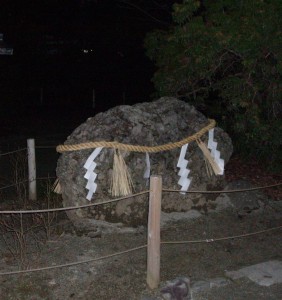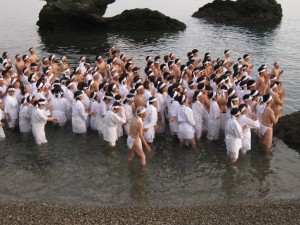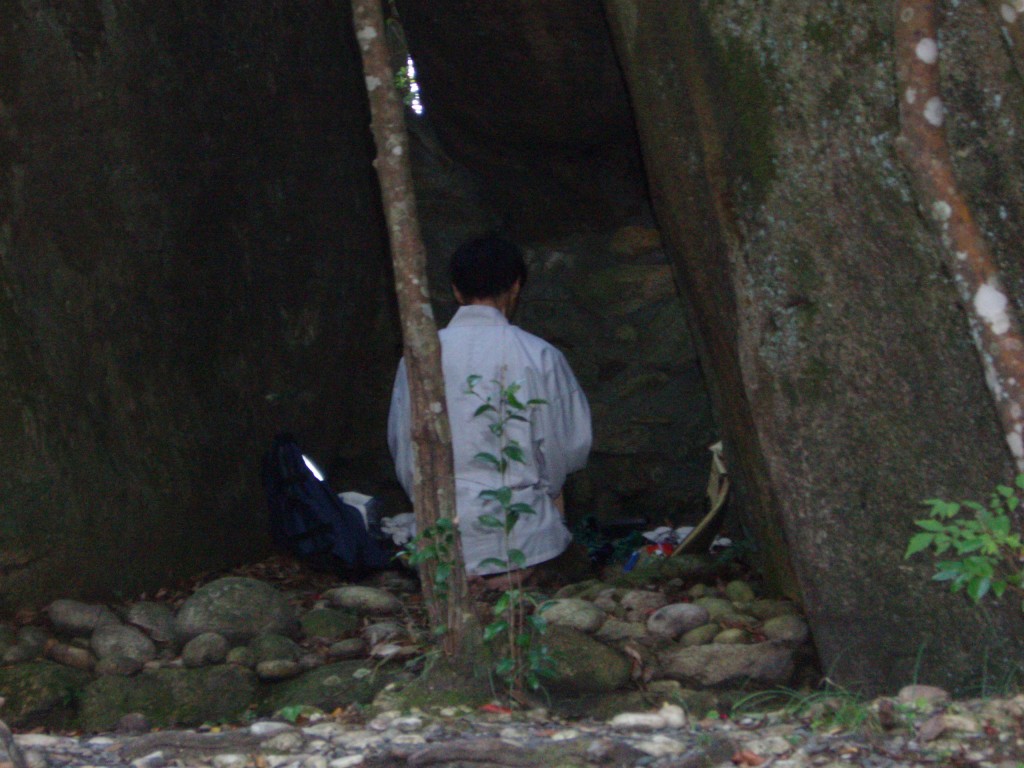In prehistoric times immigrants flowed into Japan, sometimes in a trickle and sometimes in a flood. They came for the most part from Korea and China, the bulk flowing through the Korean peninsula which lay under Chinese influence. The result was that elements of Korean shamanism and Chinese folk beliefs entered Japan. The former made itself felt in miko shamanism and the rock worship that is such a striking feature of Shinto. The latter had an even more profound impact.

Rock worship – from Korea?
Chinese folk belief comprised a mixture of nature spirits and ancestor worship. It was based on a lunar/solar calendar, which was adopted in Japan, and celebratory festivals which sought to harmonise the human and spirit worlds. This was the bedrock out of which Taoism developed. It was the same bedrock out of which Shinto developed.
It’s hardly surprising then that proto-Shinto and early Taoism share much in common. Even the name. “Shin-to” (kami-way) was the Japanese equivalent of “shen-tao”, the Chinese Way of the Spirits. Kuroda Toshio, the Japanese scholar, suggested that the first usage of the word ‘Shinto’ in Nihonshoki (720) was in effect intended to signify a Japanese form of Taoism. You could say, in fact, that Shinto was the Japanese ‘Way’, in contrast to bukkyo (the teachings of Buddhism).
One mountain, many paths
Here are some traits of early Taoism, which are echoed in Shinto.
* Sacred mountains and retreat into caves
* Veneration of swords and mirrors as religious symbols.
* An intuitive response to the world
* Suspicion of words and rationality
* Lack of dogma and doctrine
* Fluid, vague and contradictory
* Appropriated by rulers to legitimise their rule
Religious Daoism
Over time Taoism and Shinto developed in different directions. Taoism took off into individual transformation, the search for immortality and the aligning qi energy between the triad of heaven-human-earth. What had started off as a philosophy was turned into a religion. This was introduced to Japan in a big way in the seventh and eighth centuries after it had become established as a state religion in China.
With the import of Taoism came yin-yang ideas, the Five Phases, divination, astrology and fortune-telling techniques. In 604 Japan adopted the Chinese calendar and issued the 17 Article Constitution (17 derived from adding the largest yin number eight to the largest yang number, nine). One of the imported concepts involved the use of Tenno (Heavenly August One), to signify that a ruler had the mandate of Heaven. The title was adopted by the Chinese emperor in 674 and by his Japanese equivalent not long afterwards.
From as early as 675 Japan had a Ministry of Yin-Yang (Onmyoryo) which advised the government on affairs of state. Decisions were made according to the alignment of the stars, feng shui and complex divination techniques. Wizards of Yin-Yang (onmyoji) continued to play an influential part in the life of the ruling class. The ‘Merlin of Japan’, Abe no Seimei (921-1005), is a prime example.

Purification rites like this derive from Taoist influence
All these developments took place while Shinto as we know it was being shaped by the ruling class. As a result the imported ideas had a huge impact. It’s reckoned, for example, that 60% of modern Shinto ritual derives from Taoist and Yin-yang practice. The purification rites, for instance. Festivals like 7-5-3 and the throwing of beans at Setsubun. Yakudoshi (years of misfortune). The veneration of swords and mirrors. The divination and fortune-telling, too. Even the very structure and naming of Shinto’s holiest shrine, Ise Jingu (jingu derives from a Taoist term for a hall of worship).
In essence, you could say that Shinto remains the closest Japan has to the ‘Way’. Shen-tao developed into Shinto. Even now, even after the Meiji reforms stripped away onmyodo and the ecstatic side of the religion, there lies a Taoist heart beneath the Confucian concern with correctness and hierarchy. It’s found in the folk practices of Shinto. It’s found above all, in the wild abandon of Shinto festivals and the cult of sacred mountains. The way of the kami may not be the Way, but it’s close.

Yin-yang symbol

Triple tomoe - Shinto symbol
(For further reading, see ‘Shinto and Taoism in early Japan’ by Tim Barrett in Shinto in History: Ways of the Kami by Mark Teeuwen (Editor) John Breen (Editor) (Author). Also Kuroda Toshi’s ‘Shinto in the history of Japanese Religion’ tr. by James C. Dobbins and Suzanne Guy which is available on JSTOR.)


Hi John, Recently I’ve come across the concept of ‘in-yo’, which I’ve read is the Japanese equivalent of Yin-Yang. And that Inyodo is the Japanese equivalent of Feng Shui. I’ve done a fair bit of reading about Feng Shui, as well as Japan, so was surprised I hadn’t seen reference to in-yo earlier. It sounds like it is another example of an external idea being adapted to the Japanese way. Could you provide some pointers about where to find more information in English about in-yo and its application/influence in Japan? Most likely I just haven’t found the right sources yet or have overlooked it in the ones I’ve read.
Inyou is the Japanese reading of yin-yang, so basically it’s borrowed from the Chinese and then developed. Adoption and adaptation are often said to the Japanese way. As you know, the most famous manifestation of the
adaptation was the development of Onmyodo (Onmyoudou), which can be read as inyoudou. Once it was hugely influential, and though it’s not well known the practice continued with the Tsuchimikado family until the mid-nineteenth century at which point it was banned as superstition. I’ve noticed something of a comeback in recent times, sparked by New Age power spots, Harry Potter casting spells, and the boom in Abe no Seimei films. There’s a priest at a temple near where I live who does onmyodo fortune telling, and I know a couple of shrines where the priests take an interest and do simple introductions for visitors.
Thanks very much John, I hadn’t come across the alternative reading of Onmyodo as Inyoudou. Possibly western writers tend to stick with Yin-Yang and Feng Shui when they describe the Japanese versions as these concepts are more familiar with their audiences. If they referred to ‘In-you’ (also known as ‘In-yo’?) and ‘Inyoudou’ then people may not make the connection. The role of popular culture in the comeback of Onmyodo is interesting indeed. I recently discovered a photo of a fortune teller at Inari shrine in the 1910 book by H. Ponting on Japan. I was wondering if the modern priests you refer to use/discuss the long sticks that were in his image.
Hi there… I don’t know the photo or book you’re referring to there, Jann, but Inari is a very interesting faith because of its folk customs – there are still fortune tellers around Fushimi Inari, so it may be that old
onmyodo practises lingered on there when they had been superseded elsewhere by the Meiji ideologues.